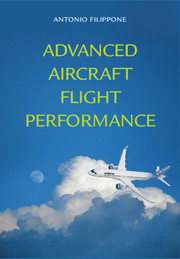Book contents
- Frontmatter
- Contents
- Tables
- Preface
- Nomenclature
- Technology Warning
- 1 Prolegomena
- 2 Aircraft Models
- 3 Weight and Balance Performance
- 4 Aerodynamic Performance
- 5 Engine Performance
- 6 Propeller Performance
- 7 Airplane Trim
- 8 Flight Envelopes
- 9 Take-Off and Field Performance
- 10 Climb Performance
- 11 Descent and Landing Performance
- 12 Cruise Performance
- 13 Manoeuvre Performance
- 14 Thermo-Structural Performance
- 15 Mission Analysis
- 16 Aircraft Noise: Noise Sources
- 17 Aircraft Noise: Propagation
- 18 Aircraft Noise: Flight Trajectories
- 19 Environmental Performance
- 20 Epilogue
- Appendix A Gulfstream G-550
- Appendix B Certified Aircraft Noise Data
- Appendix C Options for the FLIGHT Program
- Index
- References
17 - Aircraft Noise: Propagation
Published online by Cambridge University Press: 05 January 2013
- Frontmatter
- Contents
- Tables
- Preface
- Nomenclature
- Technology Warning
- 1 Prolegomena
- 2 Aircraft Models
- 3 Weight and Balance Performance
- 4 Aerodynamic Performance
- 5 Engine Performance
- 6 Propeller Performance
- 7 Airplane Trim
- 8 Flight Envelopes
- 9 Take-Off and Field Performance
- 10 Climb Performance
- 11 Descent and Landing Performance
- 12 Cruise Performance
- 13 Manoeuvre Performance
- 14 Thermo-Structural Performance
- 15 Mission Analysis
- 16 Aircraft Noise: Noise Sources
- 17 Aircraft Noise: Propagation
- 18 Aircraft Noise: Flight Trajectories
- 19 Environmental Performance
- 20 Epilogue
- Appendix A Gulfstream G-550
- Appendix B Certified Aircraft Noise Data
- Appendix C Options for the FLIGHT Program
- Index
- References
Summary
Overview
Noise propagation involves all of the physical events that take place between the noise source and the receiver. Due to the relatively large distance between source and receiver (from a minimum of ∼100 m to several kilometers), atmospheric absorption is particularly important – no less important than the determination of the noise sources themselves. If propagation takes place over an unbounded medium, the use of the atmospheric absorption model would be sufficient to estimate the effect at the receiver. However, there are cases where the topography of the terrain and the short distance between the airplane and the ground cause effects such as reflection and scattering to become important. We begin by considering briefly the airframe noise shielding (§ 17.1); we continue with the standard absorption model in the atmosphere (§ 17.2). We describe ground-reflection problems in § 17.3. We finally discuss the combination of wind shear and temperature gradients in the propagation of aircraft noise over long distances (§ 17.4).
KEY CONCEPTS: Airframe Noise Shielding, Wing Scattering, Ground Effect, Atmospheric Absorption, Wind Effects, Turbulence Effects.
Airframe Noise Shielding
A number of interference effects take place around the airframe due to the reciprocal position between noise sources and solid surfaces. The effect is frequency-dependent. The investigation of new blended airframes, which actually benefit from the noise shielding, has increased the interest in this acoustic effect.
One method is called the equivalent source method, which uses a finite number of sources to satisfy the boundary condition on the airframe to simulate the acoustic scattering.
- Type
- Chapter
- Information
- Advanced Aircraft Flight Performance , pp. 533 - 552Publisher: Cambridge University PressPrint publication year: 2012



